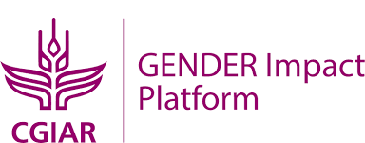By: Olamide Olaosebikan, Bello Abolore, and Owoade Durodola, International Institute for Tropical Agriculture (IITA) / GREAT RTB Fellows
In Nigeria, the world’s largest producer and consumer of cassava, Vitamin A deficiency affects 30 percent of children under the age of 5 (World Health Organization estimates), resulting in reduced immunity, impaired vision, and, in some cases, even blindness and death. Furthermore, these health impairments cost Africa’s largest economy an estimated US $1.5 billion in lost GDP every year (World Bank).
To address this deficiency, our group representing the HarvestPlus Nigeria project returned from the GREAT Gender-responsive Root, Tuber and Banana Breeding course in September 2016 to conduct surveys of women and men value chain actors in key Nigerian states. We found that traditional practices among women farmers, processors and vendors provided opportunities for increasing adoption and consumption of vitamin A-enriched cassava.
In Benue State, Nigeria, we interviewed processors, mostly women, who told us that prior to the introduction of vitamin A cassava – also called yellow cassava, because of the yellow hue imparted by the ß-carotene – they usually detoxified cassava by adding palm oil for safe consumption, good taste and fine attractive color for acceptability and increased patronage by customers who had higher preference for it.
This indigenous practice by women (also common in the South-eastern and South-southern states in Nigeria) during processing stimulated their interest to quickly adopt yellow cassava varieties when it was disseminated by HarvestPlus partners, the International Institute for Tropical Agriculture (IITA) cassava breeding unit farmers’ field day team, and the government extension services. Women were found to be innovators and early adopters due to vitamin A-cassava’s nutritional-health benefits, and the cost savings associated with reduced palm oil use.
Over time, women’s enthusiasm and active involvement in yellow cassava production, processing and marketing activities convinced men along the value chain to adopt it as well. As the men started adopting and cultivating vitamin-A cassava, they noticed that the demand for yellow cassava fresh roots kept increasing.
Women who sell vitamin-A cassava products, such as gari, fufu, abacha, bread, snacks and cakes, talked passionately about its nutritional benefits to consumers who patronized their markets and food, which included men and women of various socio-economic statuses.
In meetings with women and women’s associations, participants also talked about training and also train younger women on value addition to yellow cassava for income generation, in partnership with NGOs.
As we learned in the survey, preference, demand and acceptance of yellow cassava fresh roots, stems and products was higher in Benue State compared to Oyo State. Our GREAT-group representing the HarvestPlus team found that women were the early adopters in Benue State compared to Oyo State.
The discouraging factor for women and men farmers in Oyo State was due to low preference, demand and acceptance of the yellow cassava roots and products by consumers, due to low starch or dry matter content and inadequate awareness on the micro-nutrient health benefits. Although Oyo State is one of the leading producers of vitamin A cassava in the area of land cultivated, this production drives the commercialization of biofortified cassava with Lagos State as one of its key markets.
The consumer preference in Oyo State at the household level is comparably low, because the major staple – amala or lafun made from yam flour or cassava flour – loses most of the carotenoid content during sun-dying of the yellow cassava roots. There is a need to educate consumers for a behavioural change at the house hold level to increase vitamin A cassava consumption. Other products such as cassmoi, combo bits, and cassava custard could be introduced and promoted. On the other hand, there is higher consumption at the household level in Benue State due to preferences for yellow cassava (from a personal communication with the HarvestPlus Country Manager). Both farmers and consumers in Benue State saw the low-starch or dry matter and high vitamin-A content as beneficial to their health, which resulted in higher production, and increased demand for fresh roots, stems and products such as gari and fufu.
Scaling up adoption and sustained acceptance of yellow cassava requires increasing consumer awareness about the health benefits of yellow cassava roots, and utilizing the enthusiasm and marketing skills of women farmers, processors and marketers. These skills should be strengthened through capacity-building, training on product preparation, packaging, agri-business models to adopt, and linkages to export markets.
These findings were made possible by the exposure and training we received at GREAT trainings.
“The gender-responsive theory and practice we learned in the GREAT course allowed us to really understand adoption relationship between men and women farmers and traits preferences than we had before,” said my teammate Durodola.
Implications of the GREAT project and further work in sustainable adoption of biofortified cassava in Benue State, Nigeria includes developing and implementing gender-responsive strategies that will solve the identified gender-based constraints. This is important in ensuring gender-equitable breeding outcomes for improving health and nutritional security (especially among children and pregnant women), and increasing income among rural farming households in Benue State, Nigeria.





